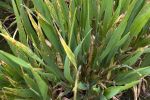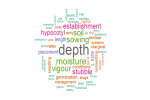While summer floods ruin unharvested grain and on-farm infrastructure, Dusty Pascoe says the stored soil moisture can be a lifesaver when following seasonal conditions turn dry.
Despite being affected by floods ahead of the 2024 season, the 43-year-old believes the inundation was a blessing for his family’s 1900-hectare farm near Raywood in northern Victoria. From December 2023 to January 2024, nearly 300 millimetres of rain fell, saturating the family’s loam-over-clay soils with a crucial moisture reserve.
After 4.8mm of rain in February and March 2024, Dusty sowed Hyola® 970CL, RGT Baseline® TT and Hyola® Blazer TT canola in early April. He uses a double-shoot knifepoint tyne and press wheel seeder set on 330mm row spacings to plant 2.2 to 3 kilograms/hectare of canola, depending on the season and variety.
For canola, 100 kilograms/ha of monoammonium phosphate is applied. After canola emergence, he spreads urea early, even before deep nitrogen soil test results are received. “I know the canola will use it,” Dusty says. All available pre-emergent herbicides are rotated to ensure optimum control of annual ryegrass.
An on-farm moisture probe fitted with a weather station guides decision-making about urea applications and spray timing. Wheat and barley sown for grain only are planted within their recommended window, while those for grazing and grain are sown up to three weeks earlier to spread the frost risk. From April to May 2024, rainfall was slightly above average, allowing Dusty to sow Scepter wheat, RGT Planet barley and Brusher oats into moisture.
Although June to October rainfall was below average, resulting in frost damage, Dusty feels fortunate that his grain yields were slightly above average. “We’re moisture farmers,” he says. “Summer rainfall is the only reason we grew a crop last year.”
His ungrazed RGT Baseline® TT, a long-season canola, escaped frost damage and yielded 2.2t/ha on average, despite looking poor all season due to low early vigour.
The ungrazed Hyola® Blazer TT canola yielded 2.2t/ha, slightly higher than its long-term average of 2t/ha.
His grazed Hyola® 970CL yielded 0.4t/ha, which was lower than hoped, mainly because it ran out of moisture and was damaged by frost.
Barley’s flexibility to yield well in dry conditions for grain, grazing or hay has secured its position in Dusty’s diverse farming business.
In 2024, our RGT Planet barley sold as malt and averaged 5.8t/ha. Our highest-yielding barley averaged 6.2t/ha, while the lowest yielded 5.6t/ha. Our Scepter wheat averaged 4.6t/ha.
Dusty’s calm approach to floods, below-average rainfall and frost arises from his dedication to enterprise diversity, careful planning and continuous learning.
In 2019, he applied for a 2020 Nuffield Scholarship to gather insights from innovative growers across Australia and the world. GRDC supported his travel to explore the benefits of grazing crops in tackling the winter feed gap amid a changing climate.
He now sees seasonal variability as a positive, delivering challenges and providing new opportunities for profit and wealth creation.

























































